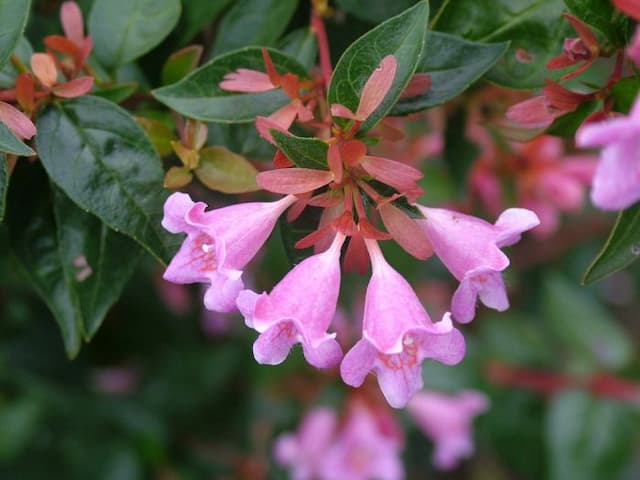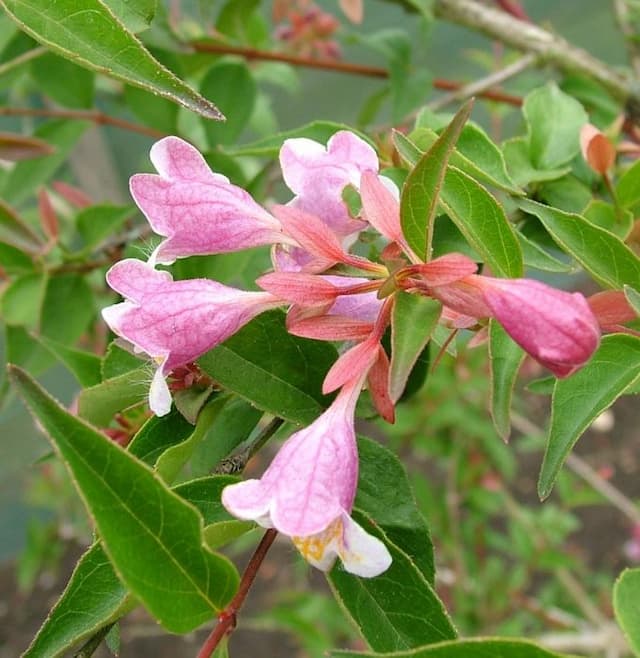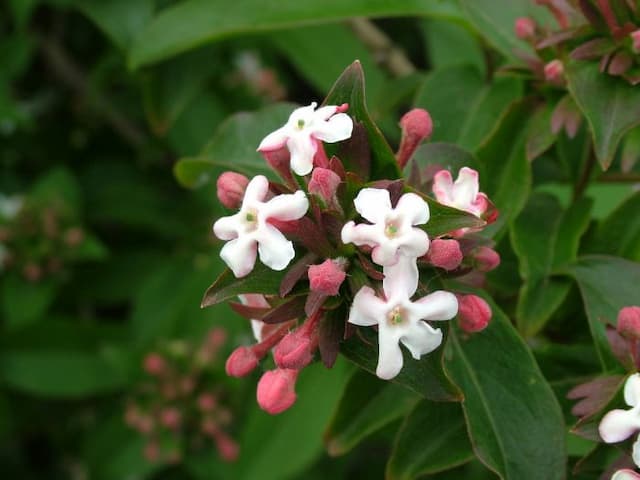Himalayan Honeysuckle Leycesteria formosa Golden Lanterns = 'Notbruce' (PBR)
![Himalayan honeysuckle [Golden Lanterns]](/_next/image?url=https%3A%2F%2Fplants-admin.emdemapps.com%2Fimages%2Fplants%2F%2Fimages%2F604b55302cc87.png&w=3840&q=75)
ABOUT
The Leycesteria formosa Golden Lanterns, commonly known as Himalayan Honeysuckle or Pheasant Berry 'Golden Lanterns', is a distinguished ornamental plant famed for its captivating features. This particular variety boasts eye-catching, golden-yellow foliage that brightens any garden setting, adding a splash of sunlight to the landscape even on overcast days. Consistently producing leaves that are heart-shaped and softly textured, it infuses a sense of playful elegance. During the flowering season, the Himalayan Honeysuckle 'Golden Lanterns' showcases pendulous clusters of flowers and bracts. The blossoms appear in a striking contrast of colors. The flowers are typically white, adorning a central position, while the bracts provide a vibrant backdrop in shades of dark red to burgundy, resembling little lanterns gracefully hanging amongst the leaves. Following the floral display, this plant continues to impress as it produces small, rounded berries. The fruits transition through a spectrum of colors as they mature, starting green then turning deep purple to almost black, often drawing the attention of birds that relish these edible offerings. Overall, the Himalayan Honeysuckle 'Golden Lanterns' presents a multilayered display of color and texture, with its attractive foliage, uniquely tinted flower clusters, and dark, shiny berries, which creates an inviting atmosphere for both human admirers and local wildlife. Its ornamental features make it a sought-after addition to a variety of garden styles, providing year-round visual interest.
About this plant
 Names
NamesFamily
Caprifoliaceae
Synonyms
Himalayan Honeysuckle, Pheasant Berry, Flowering Nutmeg, Granny's Curls, Golden Lanterns
Common names
Leycesteria formosa 'Golden Lanterns' = 'Notbruce' (PBR).
 Toxicity
ToxicityTo humans
Himalayan Honeysuckle 'Golden Lanterns' is not known to be toxic to humans. There is little information available about its toxicity, but it is not typically listed as a poisonous plant. Therefore, there are no well-documented symptoms of poisoning from ingesting parts of this plant. Nonetheless, it is generally advisable to avoid eating parts of ornamental plants due to the potential for digestive upset or allergic reactions.
To pets
Himalayan Honeysuckle 'Golden Lanterns' is not commonly known to be toxic to pets. There is limited information regarding its toxicity to animals such as dogs and cats, and it is not typically listed among plants that are poisonous to pets. Therefore, no specific symptoms of poisoning are widely recognized for this plant. However, as with humans, it is usually best to prevent pets from ingesting plants not intended for consumption to avoid any potential gastrointestinal discomfort or allergic reactions.
 Characteristics
CharacteristicsLife cycle
Perennials
Foliage type
Deciduous
Color of leaves
Variegated
Flower color
White
Height
6 feet (1.8 meters)
Spread
6 feet (1.8 meters)
Plant type
Shrub
Hardiness zones
7
Native area
Himalayas
Benefits
 General Benefits
General Benefits- Attractive Foliage: Features eye-catching golden-yellow leaves that can add color and vibrancy to a garden.
- Ornamental Berries: Produces beautiful purple-black berries that are attractive to birds and add visual interest.
- Easy to Grow: Known for being low maintenance and easy to care for, making it suitable for gardeners of all levels.
- Fast Growing: Quickly reaches maturity, providing a rapid impact in landscaping projects.
- Seasonal Interest: Offers year-round interest with its changing foliage colors and flowering habit.
- Wildlife Friendly: Attracts a range of pollinators including bees, butterflies, and birds, benefiting the local ecosystem.
- Tolerates a Range of Conditions: Can grow in a variety of soil types and is quite resilient to different environmental conditions.
- Screening Potential: With its bushy habit, it can be used to create natural privacy screens or hedges in gardens.
- Easy to Propagate: Can be readily propagated by cuttings, allowing gardeners to create new plants economically.
 Medical Properties
Medical PropertiesThis plant is not used for medical purposes.
 Air-purifying Qualities
Air-purifying QualitiesThis plant is not specifically known for air purifying qualities.
 Other Uses
Other Uses- Leycesteria formosa 'Golden Lanterns', commonly known as Himalayan Honeysuckle, can be used in floral arrangements for its attractive pendulous flowers and bracts, adding a touch of exotic elegance to bouquets.
- As a fast-growing plant, Himalayan Honeysuckle can be used to quickly fill in gaps in a landscape or garden, providing fullness and greenery where it is needed most.
- The stems of Himalayan Honeysuckle can be used in basket-weaving; they are flexible when green and can add a decorative element with their hollow nature when dried.
- This plant can serve as a visual barrier when planted in a row or hedge due to its dense foliage, offering privacy to gardens and outdoor living spaces.
- The berries of Himalayan Honeysuckle can be used as a natural dye, providing shades of purple and blue, although it should be noted that this practice is not common and may require experimentation for best results.
- With its ability to attract pollinators like birds, bees, and butterflies, Himalayan Honeysuckle can be used strategically in gardening to enhance pollination of fruits and vegetables.
- In landscaping, it can be employed to stabilize banks and slopes due to its robust root system, which helps to prevent soil erosion.
- Its ornamental features make Himalayan Honeysuckle an excellent candidate for theme gardens, such as Asian-inspired or tropical gardens, enhancing the overall aesthetic with its lush foliage and bright flowers.
- As a teaching tool in educational gardens, it can be used to demonstrate plant growth patterns and the process of natural reseeding due to its propensity to self-seed in the right conditions.
- During autumn, the plant's changing foliage color can be utilized to create natural art or mandalas as part of outdoor creative activities or mindfulness practices.
Interesting Facts
 Feng Shui
Feng ShuiLeycesteria formosa Golden Lanterns is not used in Feng Shui practice.
 Zodiac Sign Compitability
Zodiac Sign CompitabilityLeycesteria formosa Golden Lanterns is not used in astrology practice.
 Plant Symbolism
Plant Symbolism- Invasiveness: Leycesteria formosa, commonly known as Himalayan Honeysuckle, can be quite invasive in some areas, symbolizing uncontrollable growth and the potential to overwhelm other areas of one's life or garden.
- Attraction: Its flowers can symbolize attraction or magnetism, as Himalayan Honeysuckle produces vivid flowers that attract pollinators.
- Adaptability: Given its ability to thrive in various conditions, this plant can represent adaptability and resilience.
 Water
WaterHimalayan honeysuckle or Golden Lanterns requires regular watering, especially during dry spells. Water the plant thoroughly until the soil becomes saturated, but ensure proper drainage to prevent waterlogging. In general, aim to water the plant deeply once a week, providing about 1 to 2 gallons per watering session, depending on the weather conditions. In hot, dry periods, it may need watering twice a week, while in cooler or rainy weather, the frequency can be reduced. Always check the top inch of the soil before watering—if it feels dry, it's time to water.
 Light
LightHimalayan honeysuckle or Golden Lanterns thrives in full sun to partial shade. The best spot for the plant is an area that receives several hours of direct sunlight each day but is also protected from the harsh midday sun. Dappled or filtered light is ideal, especially in hot climates, to prevent scorching the leaves.
 Temperature
TemperatureHimalayan honeysuckle or Golden Lanterns prefers a temperature range between 60 to 80 degrees Fahrenheit for optimal growth. It can tolerate a minimum temperature down to around 50 degrees Fahrenheit and can survive up to a maximum of 90 degrees Fahrenheit. However, consistently higher temperatures can cause stress to the plant, so it's best to provide some shade during the hottest part of the day to keep temperatures within the ideal range.
 Pruning
PruningPruning the Himalayan honeysuckle or Golden Lanterns helps to maintain its shape and encourage bushier growth. Prune in late winter or early spring before the new growth begins. Cut back the previous year's shoots to a pair of healthy buds to stimulate flowering. Additionally, remove any damaged or crossed branches to improve air circulation. Pruning can be done annually or every other year depending on the plant's performance and desired size.
 Cleaning
CleaningAs needed
 Soil
SoilHimalayan Honeysuckle 'Golden Lanterns' thrives in a well-draining soil mix composed of loam, compost, and sand at pH levels of 6.5 to 7.5, rich in organic matter to support its growth.
 Repotting
RepottingHimalayan Honeysuckle 'Golden Lanterns' should be repotted every few years as it outgrows its pot or when the soil becomes depleted.
 Humidity & Misting
Humidity & MistingHimalayan Honeysuckle 'Golden Lanterns' prefers moderate humidity levels but is adaptable to the varying conditions found in most gardens.
 Suitable locations
Suitable locationsIndoor
Place in bright, indirect light with good air circulation.
Outdoor
Plant in partial shade to full sun; protect from strong winds.
Hardiness zone
7-9 USDA
 Life cycle
Life cycleHimalayan Honeysuckle 'Golden Lanterns' ('Notbruce') typically begins its life cycle when its seeds germinate in the spring after a period of cold stratification. The seedlings emerge and establish roots, forming a small plant that will grow rapidly in favorable conditions. Throughout the spring and summer, the Himalayan Honeysuckle 'Golden Lanterns' experiences vegetative growth, producing distinctive golden-yellow leaves and, following, its characteristic hollow stems. By summer's end, the plant starts flowering, bearing pendulous clusters of white flowers with dark reddish-purple bracts, which attract pollinators such as bees. After pollination, the flowers will develop into small, dark, berry-like fruits that attract birds, which in turn disperse the seeds. The plant then enters a period of dormancy through the winter, losing its leaves, and conserves energy to begin the next cycle when temperatures rise again.
 Propogation
PropogationPropogation time
Early Spring
Leycesteria formosa Golden Lanterns 'Notbruce', commonly known as the Golden Lanterns Himalayan Honeysuckle, is typically propagated by softwood cuttings. The best time to take these cuttings is in late spring to early summer when the plant's new growth is just hardening but still pliable. To propagate, you would cut a length of about 4-6 inches (10-15 cm) from a healthy shoot, strip the leaves from the lower half, and dip the cut end into rooting hormone. The cuttings should then be planted in a mixture of peat and perlite or a well-draining potting soil and kept moist until roots develop, a process that generally takes several weeks. It's important to provide a warm environment and maintain high humidity around the cuttings, which can be achieved by covering them with a plastic bag or placing them in a propagator.









